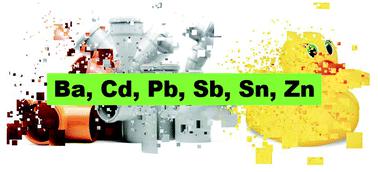当前位置:
X-MOL 学术
›
Environ. Sci.: Processes Impacts
›
论文详情
Our official English website, www.x-mol.net, welcomes your
feedback! (Note: you will need to create a separate account there.)
Polyvinyl chloride in consumer and environmental plastics, with a particular focus on metal-based additives
Environmental Science: Processes & Impacts ( IF 4.3 ) Pub Date : 2021-07-30 , DOI: 10.1039/d1em00213a Andrew Turner 1 , Montserrat Filella 2
Environmental Science: Processes & Impacts ( IF 4.3 ) Pub Date : 2021-07-30 , DOI: 10.1039/d1em00213a Andrew Turner 1 , Montserrat Filella 2
Affiliation

|
Polyvinyl chloride (PVC) is one of the most widely used thermoplastics but is also a material of concern because of the generation and release of harmful chemicals during its life cycle. Amongst the chemicals added to PVC are metal-based stabilisers and Sb-based halogenated flame retardant synergists. However, very little quantitative information exists on these additives, and in particular in PVC lost to the environment. In this study, the distribution of PVC amongst consumer plastics in societal circulation and plastics retrieved from marine and lacustrine beaches and agricultural soils are compared, along with the presence and concentrations of Ba, Cd, Pb, Sb, Sn and Zn as proxies for common metal-based additives and determined by X-ray fluorescence spectrometry. About 10% of consumer plastics and 2% of environmental plastics were constructed of PVC, with the discrepancy attributed to the long service lives and managed disposal of PVC used in the construction sector and the propensity of the plastic to sink in aquatic systems and evade detection. Metal-based additives, defined as having a metal concentration >1000 mg kg−1, were present in about 75% of consumer and environmental PVC, with Ba and Pb most abundant and Cd and Zn least abundant in both types of sample, and median concentrations statistically different only for Ba. Metals also appeared to be present as contaminants (defined as concentrations <1000 mg kg−1) arising from manufacturing or recycling. Metals in PVC are believed to pose little risk when the material is in use, but experimental evidence in the literature suggests that significant mobilisation and exposure may occur from PVC microplastics when ingested by wildlife.
中文翻译:

消费和环保塑料中的聚氯乙烯,特别关注金属添加剂
聚氯乙烯 (PVC) 是使用最广泛的热塑性塑料之一,但由于在其生命周期中会产生和释放有害化学物质,因此也是一种令人担忧的材料。添加到 PVC 中的化学品包括金属基稳定剂和 Sb 基卤化阻燃增效剂。然而,关于这些添加剂的定量信息非常少,尤其是在环境中流失的 PVC。在这项研究中,比较了社会循环中消费塑料和从海洋和湖泊海滩和农业土壤中回收的塑料中 PVC 的分布,以及 Ba、Cd、Pb、Sb、Sn 和 Zn 的存在和浓度作为常见的替代物。金属基添加剂并通过 X 射线荧光光谱法测定。大约 10% 的消费塑料和 2% 的环境塑料是由 PVC 制成的,这种差异归因于建筑行业使用的 PVC 的使用寿命长和管理处置以及塑料容易沉入水生系统并逃避检测. 金属基添加剂,定义为金属浓度 >1000 mg kg-1,存在于约 75% 的消费者和环境 PVC 中,两种类型的样品中 Ba 和 Pb 含量最高,Cd 和 Zn 含量最低,并且中值浓度仅对 Ba 有统计学差异。金属似乎也作为来自制造或回收利用的污染物(定义为浓度<1000 mg kg -1)存在。人们认为 PVC 中的金属在使用该材料时几乎没有风险,但文献中的实验证据表明,当野生动物摄入 PVC 微塑料时,可能会发生显着的移动和暴露。
更新日期:2021-08-09
中文翻译:

消费和环保塑料中的聚氯乙烯,特别关注金属添加剂
聚氯乙烯 (PVC) 是使用最广泛的热塑性塑料之一,但由于在其生命周期中会产生和释放有害化学物质,因此也是一种令人担忧的材料。添加到 PVC 中的化学品包括金属基稳定剂和 Sb 基卤化阻燃增效剂。然而,关于这些添加剂的定量信息非常少,尤其是在环境中流失的 PVC。在这项研究中,比较了社会循环中消费塑料和从海洋和湖泊海滩和农业土壤中回收的塑料中 PVC 的分布,以及 Ba、Cd、Pb、Sb、Sn 和 Zn 的存在和浓度作为常见的替代物。金属基添加剂并通过 X 射线荧光光谱法测定。大约 10% 的消费塑料和 2% 的环境塑料是由 PVC 制成的,这种差异归因于建筑行业使用的 PVC 的使用寿命长和管理处置以及塑料容易沉入水生系统并逃避检测. 金属基添加剂,定义为金属浓度 >1000 mg kg-1,存在于约 75% 的消费者和环境 PVC 中,两种类型的样品中 Ba 和 Pb 含量最高,Cd 和 Zn 含量最低,并且中值浓度仅对 Ba 有统计学差异。金属似乎也作为来自制造或回收利用的污染物(定义为浓度<1000 mg kg -1)存在。人们认为 PVC 中的金属在使用该材料时几乎没有风险,但文献中的实验证据表明,当野生动物摄入 PVC 微塑料时,可能会发生显着的移动和暴露。











































 京公网安备 11010802027423号
京公网安备 11010802027423号